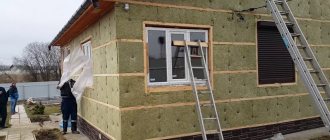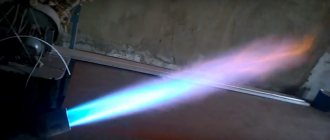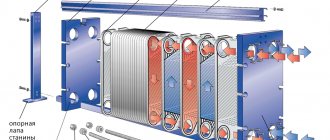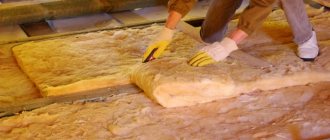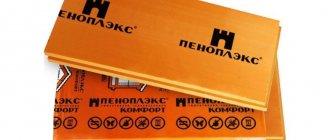What is futorka
Let's look at the highlight of this type of product, first of all let's voice the scientific definition: a fitting is a special adapter that has internal and external threads, and the diameter of the external threaded part is invariably larger than the internal one.
How can we give an example of a product variant? to ?, this marking means that we have an adapter with an internal thread diameter of ? and the outer diameter is 3/4, everything is quite simple and clear.
If you look at this group of products, you can easily notice that it is divided into two numerous groups: liners for cast iron radiators and adapters intended for bimetallic and aluminum products. Let's consider any of the options in more detail and detail.
Units for cast iron radiators
Products intended for use on cast iron radiators have the following features:
- Adapters are specially designed for connecting cast iron batteries to pipelines or shut-off valves (depending on the design of the heating system).
- Much more often you see options cast from cast iron ; they do not have any external coating, so their price is low, this option can rightfully be considered the most budget-friendly, and at the same time its reliability is very, very high.
- In addition, brass products can be used for the purpose of carrying out work , but they are much more expensive than the first option, moreover, during use, brass tends to stick tightly to cast iron, and it will be virtually impossible to remove such a connection. It is precisely on this basis that this solution is less popular among experts.
- Do not forget that depending on which side of the radiator the connection will be made, the element may have both right-handed and left-handed threads . It is better to check the direction of twisting in advance in order to know exactly what quantity and what elements will be required during the work.
- The design of the adapters is such that they can be clamped using a variety of devices - an open-end wrench, a socket wrench, a plumbing wrench. It all depends on what you have on hand, the result will be good in any case.
Advice! You should not use FUM tape to seal the threads on the futorka, since it does not tolerate high temperatures well; it is better to use the classic version with flax or modern sealing compounds.
- The products meet the following features : high pressure in the system up to 25 Bar, high temperature - 300 degrees, adapters are suitable for working with these media such as steam, water, gas, oil, air space and special coolants.
Adapters for aluminum and bimetal
This group of products is used quite often and has differences from the option described above:
- The material of manufacture is much more often high-strength galvanized steel , which is resistant to corrosion processes and ensures high reliability of all connections.
- To make the element look more attractive and be protected even more reliably, it is coated on the outside with epoxy powder enamel , which is highly durable and resistant to deformation.
- Depending on the side of placement, there are options with right-hand and left-hand threads ; you choose which ones and in what quantity you need.
- In order not to damage the surface of the product when tightening, it is recommended to use a special key , which is much more often made of plastic. With its help, you can properly tighten the connection, at the same time, the iron surface will not be damaged, and you will not overtighten the connection too much, since plastic.
- The characteristics of the products are as follows : the operating pressure should not exceed 16 Bar, and the high temperature of the coolant in the system should not rise above 110 degrees for a long time.
- As for seals, paronite or silicone rings are used much more often ; they retain elasticity for a long time and are resistant to high temperatures.
- For the convenience of customers, ready-made kits are sold , which include 4 fittings and 4 gaskets, one plug and one Mayevsky tap, and a key for the purpose of carrying out work, this is very convenient.
Radiator piping
The sectional radiator itself is a “semi-finished product” that cannot be connected to the system. Especially considering that it has a right-hand thread on one side and a left-hand thread on the other. This feature is dictated by the way individual sections are connected into a battery through a nipple, which has two sections with multidirectional threads and a gasket between them.
To connect the battery to the system, you need special fittings (futures) and plugs.
The minimum set of additional elements for connecting a cast iron battery includes two fittings and two plugs. Depending on the characteristics of the heating system and the side from which the connections are fitted, the external thread of the plugs and fittings can be left-handed or right-handed. And the internal thread of footwear is always right-handed.
If a cast-iron battery needs to be equipped with a Mayevsky valve or an automatic radiator air vent, then instead of the top plug, another fitting is screwed in.
For aluminum and bimetallic radiators, they sell ready-made kits that consist of four fittings (in pairs with left and right external threads), one plug to match the size of the internal thread of the fitting and one Mayevsky tap (plus a key for it).
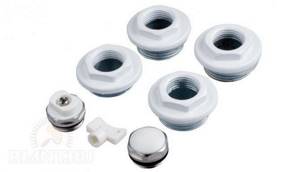
Of course, a Mayevsky tap or an automatic air vent is optional, but they make it possible to release the air lock that has formed in the battery.
Another recommended piping element for the central heating system battery is ball valves for supply and return. They make it possible to repair or replace the battery without stopping the system if a leak appears in it, as well as increase the number of sections if there is insufficient thermal power to heat the room.
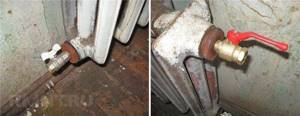
For an autonomous heating system, instead of a ball valve for the supply, it is better to install a manual or automatic thermostat.
Taps and thermostats are connected to the battery through an “American” connection, and the method of connecting them to the supply line depends on the material of the pipes.

Material
In industry, this connecting element is made of stainless steel, thanks to which the finished device is highly resistant to corrosion and, accordingly, increased strength. Thus, the futorka is one of the most durable connecting parts, because it almost never becomes covered with rust. The occurrence of corrosion on the surface of metal objects is precisely the last stage in their “life path”. After this, the metal liner begins to malfunction due to crumbling and delamination.
How to choose the right wallpaper depending on the type of room
You need to choose one or another type of wallpaper based on the room in which it will be hung.
For a bedroom, living room or nursery, you can choose any type of wallpaper at your discretion. Unless for the bedroom and nursery it is recommended to choose canvases made from natural materials. Kitchen and bathroom – rooms with high humidity levels
Therefore, when choosing wallpaper, you need to pay attention to moisture-resistant models. Corridor. Outerwear (sometimes after rain) or dirty shoes are often left in the hallway
Dust or dirt from jackets and boots can get onto the wallpaper - so choose a canvas that can be wet cleaned.
Let's take a closer look at which rooms the above materials are suitable for:
| Types of wallpaper | Bedroom | Living room | Children's | Kitchen | Bathroom | Corridor |
| Paper | Allowed | Allowed | Allowed | Not recommended | Forbidden | Not recommended |
| Non-woven | Allowed | Allowed | Allowed | Allowed | Allowed | Allowed |
| Vinyl | Allowed | Allowed | Forbidden | Allowed | Allowed | Allowed |
| Textile | Allowed | Allowed | Allowed | Not recommended | Forbidden | Allowed |
| Glass wallpaper | Allowed | Allowed | Allowed | Allowed | Allowed | Allowed |
| Liquid | Allowed | Allowed | Allowed | Forbidden | Forbidden | Allowed |
| Bamboo | Allowed | Allowed | Allowed | Allowed | Not recommended | Allowed |
| Photo wallpaper | Allowed | Allowed | Allowed | Allowed | Allowed | Allowed |
Areas of application
- Connections of pipes of different diameters in water supply systems.
- Attaching pegs.
- Replacing damaged threads by drilling. In this case, a hole of a larger diameter is drilled in the workpiece, a new thread is cut, and an adapter is screwed in.
Where are they used?
They are used in many areas:
- Plumbing. They provide a transition from one thread diameter to another, connecting pipes of different sizes.
- Furniture manufacture. Used as fastening elements for parts or accessories. Furniture fittings do not have a hexagonal head for an open-end or socket wrench, representing a sleeve with external and internal threads. Installed using a flat-head screwdriver or hex key, for which corresponding sockets are made.
- Technique. They are one of the repair options for worn threads. In particular, they are widely used in car repair shops to restore spark plugs.
The simplicity and reliability of this fitting are appreciated by consumers; the only circumstance limiting their use is the absence of certain types or sizes in the immediate vicinity.
Sometimes situations arise when the necessary fitting is not at hand or in stores. Most often these are specific samples used in repair and restoration work. In such cases, you can make the fitting yourself, using a ready-made bolt or making a thread on a rod from a suitable metal, drilling a hole along the longitudinal axis and cutting an internal thread of the required size in it.
Application in the furniture industry
No matter how strange it may seem, footwear can also be used in this area. Wide demand in the furniture industry is due to its special design. Since the futorka is a connecting element, which is a threaded part in the form of a bushing with an internal thread, it is most often used as a base for hooks (when installing furniture shelves in wardrobes). In addition, the futorka retains its properties (strength) very well on chipboard panels. That is, in order to ensure reliable fastening, craftsmen first have to drill a hole for the footing, and only then place the hook and shelf on it.
Using Compression Fittings
These products are similar to the crimps used in plastic piping. They are used when arranging collapsible connections for a section of a highway that has an outer diameter of less than 60 mm.
Install the product in the following order:
The beginning of installation is disassembling the fitting. Unscrew the clamping nut, and then remove the clamping ring located in the housing. Also take out the seal and washer.
Measure the pipe and then cut it at an angle of 90°. It is necessary to chamfer the end.
Then the seal is installed in the body of the product. The clamping nut, ring and washer are put on the pipe.
One precise movement is all it takes to press the pipe into the fitting. The pipe must pass through the seal pressed by the nut.
The collet ring is moved to the place of fixation, and then the entire system is firmly and securely fixed using a clamping nut. The tightness of the connection is ensured by the fact that the nut presses on the ring.
Using compression fittings for pipeline installation is the easiest and fastest option. But no one will give you a guarantee that such a connection is highly durable. An excellent solution in arranging communications is the use of steel pipes. Their popularity has only recently increased. Now we have managed to rid them of some shortcomings.
Modern products provide protection against corrosion processes. In addition, a variety of fittings are now used to connect them, which makes installation easier and faster. Now you know that the use of steel products makes it easier to build a reliable and durable pipeline that functions without problems for many years.
Types of footwear and the principle of their operation
Futorki are irreplaceable in cases where it is necessary to secure elements of the heating or sewage system of different sizes. Before purchasing, you should know that footwear also differs in:
- Material of manufacture . This can be cast iron, brass and galvanized steel. The first two types of products are used to connect cast iron components, as they quickly fuse with them into one whole. Steel fittings are chosen for fastening bimetallic components and are more often used when carrying out plumbing work.
- Side diameters . Measured with a ruler or caliper along the inside of the thread.
- Thread location . It can be screwed in either on the left or right side.
You can choose and purchase the right footing only if you know all the technical features of the parts being fastened - for this it is better to take with you the documentation that comes with the equipment. Footers are most often used when fastening plumbing fixtures, but this element is also relevant in the automotive industry, in the production of furniture and is used in the installation of heating systems.
In plumbing, it is sometimes impossible to do without such fasteners when the thread on one side of the pipe is worn out, and replacing the entire element involves significant expenses. In such cases, a new thread is made, onto which the fitting is attached. To avoid leaks, flax is laid, since fum tape may not withstand high pressure and high temperature.
What data is included in the drawing?
The inclusion of the following indicators describing the water supply system is mandatory when constructing an axonometric diagram. This information includes:
- Designation of risers (usually the leader line area).
- The floor level of each floor of the room, the boundary of the horizontal branch (at the axes of the pipeline), the height of the water collection points (marks along the risers).
- Diameters of system elements.
- Pipeline slope angles (indicating the slope indicator).
- Dimensions (length) of each of the independent sections of the pipeline, which include risers and horizontal branches, in millimeters.
- Coordinating dimensions (secondary information).
- Designation of nodes for the purpose of detailing the drawing.
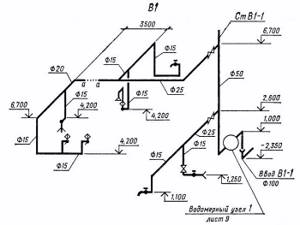
In addition to a number of basic data, accompanying documentation is attached to the diagrams, including specifications for materials and equipment.
Description of species
Futorka is characterized by the following parameters.
- Thread direction – left, right. Parts with right-hand threads are screwed in clockwise, while parts with left-hand threads are screwed in counterclockwise.
- Installation method : threaded, without external thread (drive-in).
- Thread type - all types of metric, pipe, and inch threads are used.
- View – transitional, stub. The transition (pass-through) fitting creates a transition from one diameter to another and has a through hole. The plug looks the same as a transition fitting, only at the outer end it is hermetically sealed or closed and allows you to block a section of the pipe and is placed on the radiator.
- Direct or reverse footing. In a straight fitting, the diameter of the external thread is larger than the internal one. But there are also parts of non-standard design - the opposite. They are equipped with a special thickening at one end (flange), on the inside of which there is a thread of a larger diameter than the diameter of the thread on the outside of the fitting.
Products may have:
- spacer mechanism (most often a spacer ball);
- hex head or gas wrench;
- flange.
Furniture footings can be equipped with fastening clamps and spikes. Spring repair fittings have a tongue that makes installation easier.
Plumbing
In plumbing, transitional fittings are most often used - to connect pipes, various appliances, and radiators. For these purposes, along with direct ones, reverse fittings are often used. Also in great demand are plugs, which are used to seal lines and are placed on the battery. To connect the radiator to the pipelines, special radiator fittings are used. They are often sold in a mounting kit of 4 pieces (two with left-hand threads, and two with right-hand threads).
Plumbing fittings usually have a pipe or inch thread; it can be left-handed or right-handed.
Right-hand threads are more common; they are used on most pipes and connecting pipes of various equipment (water heaters, pumps, filters). Left-hand threads are used on pipes that connect to the radiator on the left side. Metric threads are not usually used for the pipes themselves, but can be used to connect various devices - for example, pressure gauges or gearboxes.
The most popular sizes are those that correspond to the most common pipe diameters: these are universal products that comply with GOST. A typical plumbing fitting has a thread diameter ranging from ½ to 2 inches (8-50 mm). For larger cross-section pipes, threaded fittings are rarely used. Thread length - from 13 to 28.5 mm, total product length - from 17.5 to 39.5 mm.
Repair
The main type of repair fittings are threaded spiral (spring) inserts. Externally, such a part is a springy spiral made of steel wire with a diamond-shaped cross-section, equipped with a protrusion or tongue on one side. The tongue is necessary to facilitate installation; after installing the foot, it is bitten off.
Characteristics:
- made of corrosion-resistant steel, can be used in aggressive environments;
- the restored thread is more resistant to mechanical damage, the insert does not have the effect of “biting” damaged hardware;
- loads are evenly distributed and absorbed along the entire length of the connection, and not just due to the 2-3 upper turns;
- the connection becomes 2-4 times stronger and lasts longer.
Due to its unique qualities, such an insert is used not only for repairing damaged threads, but also for strengthening rigid threads in places of important, highly loaded connections in aviation and space technology, nuclear reactors, and medical equipment.
In everyday life they are used to repair broken threads on pipes and on various mechanisms - for example, to restore the spark plug threads of a car engine.
The parameters of spiral inserts for general industrial use and those most commonly used in everyday life usually correspond to the DIN 8140 standard. The length of such an insert is made a multiple of its diameter in the mounted state. Standardly these are 1D, 1.5D, 2D, 2.5D, 3D, where D is the diameter.
Furniture
Furniture lining is used not as a fitting, but as a fastener with which you can make a socket for attaching counter hardware to surfaces made of wood, wood board, or plastic. That is, it works like a nut immersed in the material.
The difference between furniture fittings and other types (plumbing, repair) is that only metric threads are used.
Along with parts of the standard type (with external and internal threads), a special type of footing is used for furniture fastening, in which the thread is applied only on the inside of the hole, and on the outside, instead of threads, a locking notch and spikes are used for adhesion to the material.
The outer part of the foot is screwed or driven into the material, where a hole of the required diameter has been pre-drilled. When installing a part with external threads, it automatically cuts threads in the material, since chipboard, wood and similar materials have a relatively soft structure. The drive-in sleeve (without external thread) is simply driven in with a hammer. Some are equipped with a spacer mechanism.
The internal thread is used to install hardware that is used to attach the second part. Due to this, it is possible to create various types of furniture fastenings - both simple screw ones, consisting only of the fitting itself and a counter screw, and more complex ones, where the fitting is used as part of a complex mechanism - for example, eccentric ties, door fastenings, folding and sliding structures.
The futorka is mounted discreetly and does not spoil the design of the furniture.
At the same time, the connection is very reliable, it allows you to absorb the impact on the material, therefore it is applicable not only for hard wood, but also for soft, crumbling materials (chipboard, plywood), plastics, for which not every type of fastener is suitable. In addition to furniture itself, this type of fastener is used for a wide variety of wooden and plastic structures. With its help, for example, fastenings for balusters and railings are created, and the handrails themselves are assembled to the required length. It can also be used for cladding work - for fastening wooden panels.
Furniture footings come in metal and plastic and are made for various counter hardware (screws, screws, self-tapping screws, studs) and plastic fasteners. The production of furniture fasteners is not strictly regulated by GOST; it is often non-standard. Nevertheless, the most popular are universal fittings, which can be used for assembling furniture and for a wide range of household tasks - for a standard GOST/DIN screw from M4 to M20.
Their typical sizes:
- internal diameter from 4 to 20 mm (M4 to M20);
- external – from 6 to 29 mm;
- thread pitch – from 0.5 to 1.5 mm;
- height – from 8 to 20 mm.
Purpose
The connecting product, due to its design feature, is an important element in assembling and repairing furniture. The furniture fitting is a fitting with a metric internal thread and an external screw thread. Widely used when installing shelves in cabinet and kitchen furniture, as a base for hooks.
The part is well suited for connecting complex planes, especially with rectangular end joints, for assembling and disassembling furniture made of chipboard, MDF and soft wood. The part, providing reliable fastening, is quite technologically advanced, has the correct thread pitch, diameter size, low degree of surface roughness, and tightness.
The main service purpose of the part is screwing or driving into a prepared hole on the surface. The hardware, coinciding with the passage in diameter and thread, ensures an accurate, strong connection and does not allow gaps and distortions between fastener elements. The product, even with an increase in the contact area, can withstand the load well.
The product is technologically advanced in its design features: it effectively reduces time costs and contributes to the quality of furniture manufacturing and repair. To improve anti-corrosion resistance, parts are coated with chrome or zinc.
The service life of all furniture depends on the quality of the product. A thread or diameter discrepancy even by a millimeter can cause a malfunction of sliding, retractable, or transforming parts.

Main varieties
Plumbing fittings, in turn, are divided into two groups.
Adapters of the first group are used for installation in cast iron pipelines, heating radiators or plumbing fixtures. Their advantages:
- relatively low price;
- withstand pressure up to 25 Bar and temperature up to 300 °C;
- possibility of contact with hot water, steam, oil;
- availability of parts with right and left threads.
Fittings of the second group are intended for aluminum or bimetallic connections. Usually made of galvanized steel and have the following advantages:
- corrosion resistance;
- withstand pressure up to 16 Bar and temperature up to 110 °C;
- installed with special tools that do not damage the pipeline or radiator;
- the presence of a special powder enamel coating.
Futorki differ in purpose, depending on the scope of use: plumbing, furniture and repair .
The material from which the adapter is made also depends on the area of use and the amount of load it will experience. Main materials of manufacture:
- cast iron;
- Cink Steel;
- brass;
- aluminum;
- plastic.
It is impossible to compile an exhaustive list of all types of these fittings, since they are produced by individual manufacturers for certain units or parts. However, all adapters are produced in accordance with technical standards and GOST requirements, so that a part, for example, with a cross-section of ½ or ¼, exactly matches the thread of a pipe or radiator.
Nuances of fastening
An adapter with a through hole, regardless of the material of manufacture, allows the rotational action to be carried out evenly, progressively, without much tension. The main difficulty when installing a part is maintaining high accuracy when drilling a hole.
When using a part, special attention is paid to its outer and inner diameters and thread pitch. When they come into contact with threaded hardware, they must align. When installing the footer, you must:
- the centers of the mounting hole and the part being connected were coaxial, so as not to break the hole or impair the strength of the connecting elements;
- When manually drilling a non-through hole, care was taken not to damage the front side of the formation;
- When screwing the part into hardwood, a special lubricant or wax was used to facilitate screwing. The tightening force is adjusted according to the protruding excess substance;
- the hole was drilled perpendicular to the surface of the panels being connected to prevent them from spreading during the installation of the screed.
When working with fasteners, they usually use an electric drill with a soft start function and a furniture jig for drilling, which is very popular among furniture makers. Using a unique device, drilling for fasteners and fittings is performed with high accuracy and speed, which makes it possible to correctly fix the fitting.
The main structural element is a sleeve designed to guide the drill. The tool is made from wood, MDF, chipboard, metal and plastic, which greatly facilitates the installation of threaded fittings made from various groups of materials.
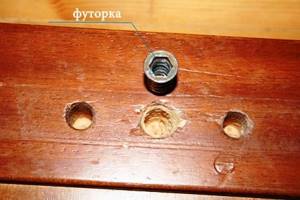
Basic principles for selecting components
Any purchase is based on certain criteria. This does not exclude components for assembling heating systems.
The following series of requirements are identified that apply to such elements, including footers:
- Size – lack of information about the parameters of the equipment for which you need to purchase components will not give a positive result. For example, if the part differs by even one inch, then such a connection will not be reliable. This may cause leakage. If it is customary to install the system on your own, but there is no experience in this matter, then it is recommended to take documentation with you to the store, for example, for radiators or other previously purchased equipment. This will not only make it easier for the sales consultant to find the necessary parts, but will also help the buyer himself understand this matter.
- Heating system plan - having a sketch will allow you to determine the location of all important components, as well as their number. Of particular importance when selecting components is their location relative to each other. Such a drawing will allow you to identify important points, as well as emphasize individual problem areas.
- Thread – you need to select the fitting to match other parts with the appropriate parameters. An inch of error will result in the inability to connect such parts. Despite the fact that manufacturers produce components of certain standards, in order to eliminate possible mismatches, experts recommend familiarizing yourself with the features of the parts in advance. The instructions supplied with the equipment will help with this.
- Product quality – you can evaluate components according to this parameter visually. If the part is of good quality, then the thread, regardless of whether it is outside or inside, should be smooth without any damage. This also applies to other surfaces. They, in turn, must also be well processed.
- Material – you need to buy parts based on information about the equipment itself for which the components are selected. So, for a cast iron radiator you need to take a cast iron threaded fitting. But for bimetallic and aluminum products, the best option would be an item made of galvanized steel.
- Checking the elements - when making a purchase, you should definitely check the part in practice. You just need to screw the component onto the double thread. If this is done easily and without unnecessary resistance, then the part is good. Otherwise, the thread is damaged and purchasing this product is not advisable.
Criterias of choice
The fittings are selected depending on the cross-section and material of the products being connected. A special table will help you determine the appropriate diameter parameters. The diameter of the thread depends on its pitch and the number of threads per inch.
Fittings for cast iron system elements are highly durable and can withstand high loads. Products of the second group are used in milder conditions, which should be taken into account when choosing a suitable connector.
When purchasing, carefully inspect the adapters, being careful not to miss mechanical damage, cracks or other surface defects. It’s great if you can try to attach the fitting to a part with a suitable thread. The connection should be made easily, without tension and over the entire length of the thread. Otherwise, it is better to choose another sample or type of fitting.
Sometimes situations arise when the necessary adapter could not be found in the store. Usually these are specific samples for repair and restoration work. In this case, you can make a futor with your own hands from a bolt and a rod of suitable metal by drilling a hole along the longitudinal axis and cutting an internal thread of the required size in it.
Thus, the futorka allows you to solve the problem of connecting parts with different sections without the use of welding or complex technical devices. Even an unprepared consumer can buy and install such a fitting. The main thing is to choose the right product in terms of thread and size. If no mistakes are made, the installed fitting can last for many years without hassle.
Recommendations for choosing components
First, let's look at what criteria you should pay attention to when choosing components for assembling a heating system; these recommendations will apply not only to the footers, but also to all other necessary elements:
| True to size | If you do not know the parameters of the equipment, then it is unlikely that you will be able to purchase components; in extreme cases, if you decide to do the work yourself for the first time, take documentation for radiators and other equipment included in the system so that the seller can figure out what you need |
| Availability of a heating system plan | This is much more important than you think, so you must make a sketch; perfect accuracy is not required from you. The main thing is a clear definition of the location of all nodes in the system and the features of their location relative to each other. This will greatly help in determining the exact quantity of certain components, you will not miss important nuances |
| Thread matching | Another important factor, since the type of connection and its pitch may vary. Moreover, differences can be both in the measurement system (inch or metric) and in the thread pitch. Of course, most manufacturers try to produce products according to certain standards, but nevertheless, some features still occur, and it is important to know about them in advance (again, the instructions included with the equipment will help) |
| Product quality | You can determine how well a particular product is made by eye - the carvings inside and outside must be smooth without flaws or damage, other surfaces must be smooth and well-finished. If we are talking about components for aluminum and bimetallic radiators, then the products are most often painted white, since most radiators have exactly this color |
| Material of manufacture | The liner for a cast iron radiator must be made of the same material as the main element; as for bimetallic and aluminum radiators, the optimal solution for them is products made of galvanized steel, they are quite reliable and durable, and their price is affordable |
| Checking elements | It is best to check how well the element screws onto the thread; if you are purchasing many units, then check at least a few of them to choose from. The parts should screw on fairly easily without any effort on your part. If resistance is felt, then the thread on one of the elements is damaged. |
Advice! We recommend purchasing components from the same company as the main components. In general, the easiest way is to buy everything you need in one store, then specialists will assemble the entire set for you, and you will save a lot of time, since you don’t have to figure everything out yourself, everything will be explained right on the spot.
When carrying out work, you may need a variety of components and components.
Tips for choosing components
First, let's look at what specific criteria to pay attention to when choosing components for assembling a heating system; these tips will apply not only to footers, but also to all other necessary elements:
| True to size | If you do not understand the parameters of the equipment, then it is unlikely that you will be able to buy components; in extreme cases, if you decide to do the work yourself for the first time, take documentation for radiators and other equipment included in the system so that the seller has the opportunity to understand what you need |
| Availability of heating system design | This is much more serious than you think, based on this, you must make a sketch; you are not required to be completely accurate. The main thing is a clear definition of the placement of all nodes in the system and the features of their placement relative to each other. This will greatly help in determining the correct quantity of certain components, you will not miss important nuances |
| Thread matching | Another serious factor, since the type of connection and its progress may vary. Moreover, there can be differences both in the measurement system (inch or metric) and in the thread pitch. It goes without saying that most manufacturers try to produce products according to certain standards, but some features are still visible, and it is fundamentally important to know about them in advance (again, the instructions included with the equipment will help) |
| Product quality level | It is possible to find out how well a particular product is made by eye - the threads inside and outside must be smooth without flaws or damage, other surfaces must be smooth and properly processed. When it comes to components for aluminum and bimetallic radiators, the products are much more often painted white, since most radiators have just this color |
| Material of manufacture | The liner for a cast iron radiator must be made of the same material as the main element; as for bimetallic and aluminum radiators, products made from galvanized steel are a good solution for them; they are quite reliable and durable, and at the same time their price is affordable |
| Checking elements | It’s best to check how well the element screws onto the thread; if you receive a large number of units, then make sure that at least a couple of them are reliable. The parts should screw on fairly easily without any effort on your part. If resistance is felt, then the thread on one of the elements is damaged |
Advice! We recommend purchasing components from the same company as the main components. By and large, the easiest way is to purchase everything you need in one store, then the experts will put together a whole kit for you, and you will save a lot of time, since you will not need to figure everything out yourself, everything will be explained right on the spot.
Dimensions
Footers are available in different sizes for different tasks. They can be guided by GOST/DIN standards, or they can be non-standard, depending on the design solutions of the furniture manufacturer. Atypical ones are usually not sold separately, but come as a set when ordering ready-made furniture. But mainly manufacturers focus on the DIN 7965 standard for mortise furniture couplings.

That is, the inner diameter of the fitting is selected in the same way as a regular nut: a counter screw of the same diameter is attached to it (for an M4 fitting - an M4 screw, and so on). The most popular sizes: M4, M5, M6, M8, M10. There are also couplings for screws, studs, and self-tapping screws.
To choose the right fitting, in addition to the diameter of the internal thread, you also need to take into account its external diameter and length. The outer diameter is usually from 6 to 29 mm. Thread pitch – from 0.5 to 1.5 mm. The outside diameter determines the size of the hole that is drilled into the material. Along with this parameter, you need to take into account the method of fastening - threaded fitting, with a notch, with a spacer mechanism, and so on.
Length is how deep the sleeve will go into the material. Typically this parameter is from 8 to 20 mm. You need to choose the length of the futurka based on the fact that there is at least a few millimeters left to the front side (the hole is usually not made through). And also the sleeve should not stick out and interfere with the installation of other fittings.
At the same time, the length must be sufficient for the fastening to be strong and withstand the required loads. Therefore, one of the most popular options is a sleeve with a ratio of outer diameter and length of 10x13 mm for a standard screw. It is considered universal. Although a number of tasks may require miniature fasteners or, conversely, long bushings for highly loaded fasteners.
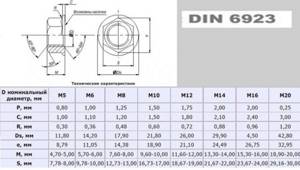
Peculiarities
Futorki for thread restoration are special inserts that are applied to old connections. At the same time, they provide additional protection for the fastenings and their reliability. Can be used in spark plug wells.
Most often, such inserts are used for cast iron and aluminum fasteners. These products have a spiral surface and are made exclusively from materials that are highly resistant to corrosion.
Threaded inserts are usually made of stainless steel. Products made from such a metal base have a high level of strength, wear resistance and durability. Often the surfaces of these parts are additionally coated with special protective compounds that prevent them from corroding.

